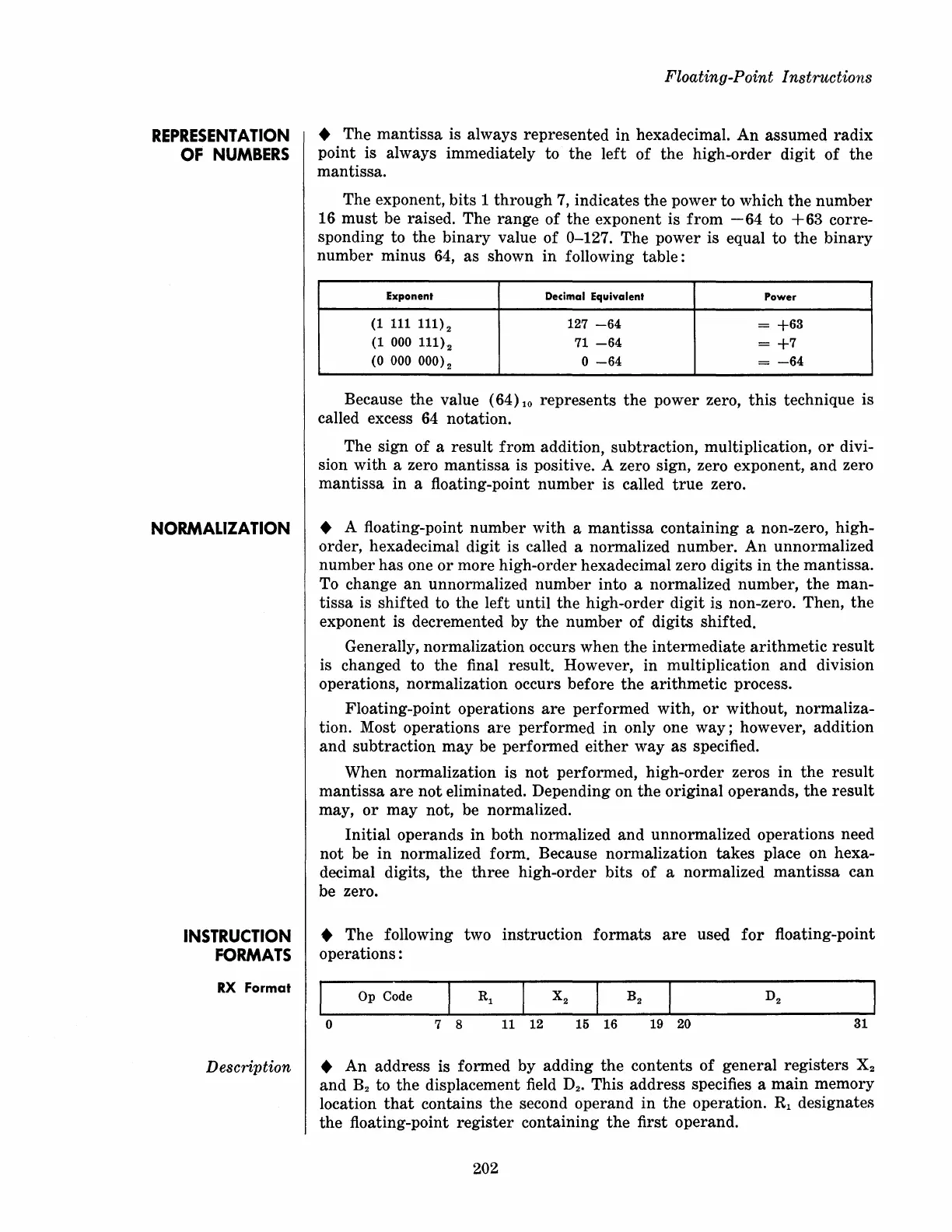REPRESENTATION
OF
NUMBERS
NORMALIZATION
INSTRUCTION
FORMATS
RX Format
Description
Floating-Point Instructions
•
The
mantissa
is always
represented
in
hexadecimal.
An
assumed
radix
point
is always immediately to
the
left
of
the
high-order
digit
of
the
mantissa.
The exponent,
bits
1
through
7, indicates
the
power
to which
the
number
16
must
be raised.
The
range
of
the
exponent is
from
-64
to
+63
corre-
sponding to
the
binary
value
of
0-127.
The
power
is equal
to
the
binary
number
minus
64,
as
shown
in
following
table:
Exponent
Decimal Equivalent
Power
(1 111 111) 2
127
-64
=
+63
(1 000 111)2
71
-64
=
+7
(0 000 000)2
o
-64
=
-64
Because
the
value (64)
10
represents
the
power
zero,
this
technique is
called excess 64 notation.
The sign
of
a
result
from
addition, subtraction, multiplication,
or
divi-
sion
with
a zero
mantissa
is positive. A zero sign, zero exponent,
and
zero
mantissa
in
a floating-point
number
is called
true
zero.
• A floating-point
number
with
a
mantissa
containing
a non-zero,
high-
order, hexadecimal digit is called a normalized
number.
An
unnormalized
number
has
one
or
more
high-order
hexadecimal zero
digits
in
the
mantissa.
To change
an
unnormalized
number
into a normalized
number,
the
man-
tissa
is
shifted
to
the
left
until
the
high-order
digit
is non-zero. Then,
the
exponent is decremented by
the
number
of
digits
shifted.
Generally, normalization occurs
when
the
intermediate
arithmetic
result
is changed to
the
final result. However,
in
multiplication
and
division
operations, normalization occurs before
the
arithmetic
process.
Floating-point
operations
are
performed
with,
or
without,
normaliza-
tion. Most operations
are
performed
in
only one
way;
however, addition
and
subtraction
may
be
performed
either
way
as
specified.
When
normalization is
not
performed,
high-order
zeros
in
the
result
mantissa
are
not
eliminated. Depending on
the
original
operands,
the
result
may,
or
may
not, be normalized.
Initial
operands
in
both
normalized
and
unnormalized
operations
need
not
be
in
normalized form. Because nornlalization
takes
place on hexa-
decimal digits,
the
three
high-order
bits
of
a normalized
mantissa
can
be zero.
•
The
following two
instruction
formats
are
used
for
floating-point
operations:
o
7 8 11 12 15 16 19 20
31
•
An
address
is formed by
adding
the
contents
of
general
registers
X
2
and
B2
to
the
displacement field D
2
. This
address
specifies a
main
memory
location
that
contains
the
second
operand
in
the
operation.
Rl
designates
the
floating-point
register
containing
the
first operand.
202

